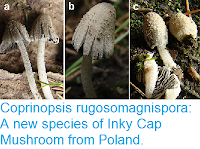Waxy Cap Mushrooms, Hygrophorus spp., are fleshy, often edible Mushrooms that form mycorrhizal associations (associations between Fungi and
Plants in which the Fungus receives sugars produced by the Plant and the
Plant receives nutrients obtained from the soil from the Fungus) with a
variety of forest trees, including both Broadleaved and Coniferous species; each species of Fungus typically forms associations with a single species of tree. These Fungi are found in woodland around the world, from tropical forests to the boreal forests of the subpolar regions.
In a paper published in the Turkish Journal of Botany on 20 November 2017, Ertuğrul Sesli of the Department of Biology Education at the Karadeniz Technical University, Vladimír Antonín of the Department of Botany at the Moravian Museum, and Marco Contu of Olbia in Italy, describe a new species of Waxy Cap Mushroom from Trabzon Province in northeastern Turkey.
The new species is named Hygrophorus yadigarii, in honour of the late Yadigar Sesli, the father of Ertuğrul Sesli. This Fungus produces Mushrooms up to 60 mm across and 70 mm high, which start out hemispherical and become flat as they grow, and are white-to-cream in colour, sometimes with a bluish sheen. The species was found in a Hornbeam-Spruce dominated forest in the Maçka District of Trabzon Province.
Hygrophorus yadigarii, wild specimen. Scale bar is 30 mm. Ertuğrul Sesli in Selsi et al. (2017).
See also...
Follow Sciency Thoughts on Facebook.







